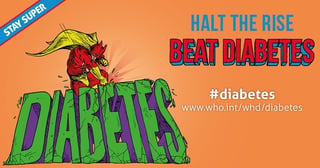- Privacy Policy
- Terms & Conditions
- Contact us
- ©Isabel Healthcare 2025
The growing problem that is diabetes - World Health Day 2016
 It’s World Health Day again, falling as usual on World Health Organization’s birthday, on Thursday 7th April. Last year we wrote a blogpost about Food Poisoning for the food safety focus of 2015’s campaign. This year, however, the topic WHO are getting everyone to think and talk about is Diabetes.
It’s World Health Day again, falling as usual on World Health Organization’s birthday, on Thursday 7th April. Last year we wrote a blogpost about Food Poisoning for the food safety focus of 2015’s campaign. This year, however, the topic WHO are getting everyone to think and talk about is Diabetes.
Type 2 diabetes is the largest growing concern across the globe, and this is particularly apparent in the US and UK. 1 in 11 adults have some form of diabetes worldwide, and what’s even more concerning is the rate at which children are starting to get type 2 diabetes, which is a condition brought upon largely through lifestyle choices, poor diet and obesity. In 1994, only 5% of young people diagnosed with diabetes had type 2 diabetes, with the rest suffering from type 1 diabetes which is not caused by a poor lifestyle. Today, however, that number has increased to around 40-50% depending on the area of the USA. In adults, type 2 diabetes is growing at such an alarming rate that some proffessionals are referring to it as an epidemic, estimating that 1 in 3 Americans will have the condition if nothing changes between now and 2050. All these statistics just go to show why WHO have chosen this rising issue as the focus for World Health Day.
What is Diabetes?
Diabetes is a condition which affects the pancreas’ ability to create insulin, or stops insulin being used properly. Insulin is crucial for the body’s normal function as it helps all the cells in your body absorb the glucose it needs for energy. In type 1 diabetes, the pancreas fails to create any insulin at all, so no glucose can be absorbed into the body without the help of medicated insulin. In type 2 diabetes, however, the body has developed a resistance to the insulin the pancreas produces, meaning the cells can’t absorb the glucose because the insulin can’t get in. The insulin can’t go anywhere, the glucose can’t go anywhere, the cells think they need more insulin to get hold of the sugar and a vicious cycle begins which eventually leads to huge problems and can be fatal through sugar levels being too high or low in the body, and many complications surrounding diabetes. This video made by Diabetes UK is brilliant at explaining the different types and symptoms:
Diabetes Symptoms
For type 1 diabetes, the symptoms will present themselves and worsen quite quickly over a matter of weeks, whereas type 2 diabetics develop the symptoms much slower and may not notice the condition for several years. There is some variation in symptoms between type 1 and 2 diabetes, but the following can occur in both:
- Thirst
- Frequent urination
- Thrush or genital itching
- Tiredness
- Weight loss
- Blurred vision
- Slow healing of wounds
- Nerve damage, particularly in the limbs.
What can I do this Diabetes Day?
The most important thing for us to stop the spread of diabetes worldwide is to educate people on not only the symptoms, as the quicker the condition is detected the easier it is to control and treat, but more importantly on the causes of type 2 diabetes. Type 1 diabetes is, at the moment, an autoimmune disease we don’t understand and cannot prevent, but type 2 is so closely linked to lifestyle and being overweight that some easy changes could help stop the onset of both the disease in an individual and the epidemic as a whole.
The WHO have released their first ever diabetes report with 100s of statistics and pieces of information. Have a read of them and if you want to get even more involved, the aim is to get influential companies and governments to take this growing condition as more of a threat and put measures in place to stop it.
Diabetes is not just a health concern, and WHO are emphasising this throughout the buildup to World Health Day. The condition is expensive to treat and with so many people developing the disease, some less privileged countries are already struggling to cope, and the bigger developed countries won’t be far behind. Because of this, some countries need our help and charity to be able to tackle the disease, as well as more fortunate countries around the globe needing to put a plan in action to help cope with the growing numbers and stop the incline.
There is a lot more information on the WHO website on what you can do to help this World Health Day, but as always the most important thing is to educate and raise awareness on the causes, symptoms and available treatments of all diabetes.
If you are concerned about your symptoms and think you may have diabetes, put your symptoms into the Isabel Symptom Checker, and discuss them with a healthcare professional:

Mandy Tomlinson
Mandy has worked for Isabel Healthcare since 2000. Prior to this, she was a Senior Staff Nurse on the Pediatric Infectious disease ward and high dependency unit at one of London's top hospitals, St Mary’s in Paddington which is part of Imperial College Healthcare NHS Trust. Her experience in the healthcare industry for the past 33 years in both the UK and USA means she's a vital resource for our organization. Mandy currently lives and works in Scottsdale, Arizona.
Subscribe Here!
Recent Posts
Isabel DDx Companion with ChatGPT Integration - to help you diagnose even faster
At Isabel Healthcare, we’ve always been driven by one goal: to make clinical reasoning faster,..Virtual Triage: Do more questions lead to better patient outcomes?
One of the common misconceptions related to virtual triage / symptom checker tools is that the more..List Of Categories
- Differential Diagnosis Decision Support
- Differential diagnosis
- Symptom Checker
- Symptoms
- Medical Error
- Patient Disease Information
- Disease
- Clinical Decision Support
- Diagnostic Decision Support
- Isabel 1 Minute Read
- Diagnosis Error
- Diagnosis Skills Cases
- Healthcare Informatics
- Clinical Reasoning
- Evidence-based Medicine
- Medical Education
- Patient Engagement
- Symptom Triage
- Nurse Practitioner Education
- Nursing Decision Support
- Partnership
- Public Health
- COVID-19
- EHR
- Patient Empowerment
- Patient Safety
- rare disease

Start your FREE Trial today
Try the Isabel Pro DDx generator for 30-days - no payment card details required.




